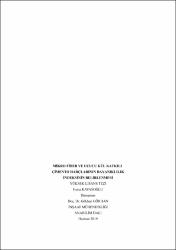| dc.contributor.advisor | Görhan, Gökhan | |
| dc.contributor.author | Kavasoğlu, Esma | |
| dc.date.accessioned | 2019-10-30T07:44:24Z | |
| dc.date.available | 2019-10-30T07:44:24Z | |
| dc.date.issued | 2019 | en_US |
| dc.identifier.uri | https://hdl.handle.net/11630/7126 | |
| dc.description.abstract | Yapılan çalışmada hammadde olarak CEM I 42.5 R tipi çimento ve uçucu kül (UK) kullanılmıştır. Uçucu kül, Kütahya Tunçbilek Termik Santralinden tedarik edilmiştir. Harçların üretiminde 3 farklı boyda (6 mm, 12 mm ve 24 mm) lif kullanılmıştır.
Harç numunelerinin hazırlanmasında hammadde olarak kullanılan çimento ve UK malzemeleri en iyi tepkimeyi verecek şekilde farklı oranlarda karıştırılmıştır. Karışımlara toplam bağlayıcı miktarına göre % 0.5 oranında lif ilave edilmiştir. Laboratuvar tipi çimento mikserde hazırlanan karışımlar 4 x 4 x 16 cm ebatlarında metal kalıplara vibrasyon yöntemiyle yerleştirilmiştir. Kalıplarda priz alması beklenen örnekler bir gün bekletilmiş ve kalıptan alınarak su tankına yerleştirilmiştir. 28 ve 90 günlük kür süresinin ardından harç numunelerinin fiziksel özellikleri Arşimet prensibine göre belirlenmiştir. Ardından numunelerin basınç ve eğilme dayanım testleri (28 ve 90 günlük) yapılmıştır.
Numunelerin dona karşı durabilite indeksinin belirlenebilmesi amacıyla seçilen örnekler üzerinde bazı fiziksel deneyler ve civalı porozimetre deneyi uygulanmıştır. Elde edilen bulgulara göre; 90 günlük numunelerde % 20’ye kadar yapılan UK ikame oranlarının basınç dayanımlarını arttırdığı tespit edilmiştir. 28 günlük R1228 kodlu numuneler 46.4 MPa, 90 günlük 2U1290 kodlu numuneler ise 49.1 MPa ile en yüksek basınç dayanım değerini vermiştir. Sonuç olarak, kür süresinin artması ile birlikte numunelerin dayanımlarında artış olduğu ve ikame edilen UK oranlarının % 30 ve üzeri olduğu numunelerde su emme kapasitesinin arttığı ve neticede mekanik dayanımın azaldığı tespit edilmiştir. Durabilite indeksi verileri dikkate alındığında ise bünyeye eklenen UK ikamesinin durabilite özelliklerini geliştirdiği bununla birlikte lif boylarının ise değişken sonuçlar vermekle birlikte durabilite açısından 12 mm’lik lif kullanımının daha uygun olduğu kanaatine varılmış olup genelde örneklerin tümünün yeterli donma direnci durabilitesine sahip olduğu düşünülmektedir. | en_US |
| dc.description.abstract | In the study, CEM I 42.5 R type cement and fly ash (UK) were used as raw material. Fly ash is obtained from the Tunçbilek Thermal Power Plant in Kütahya. Three different sizes (6 mm, 12 mm and 24 mm) fiber are used in the production of mortars.
Cement and UK materials used as raw materials in the preparation of mortar samples were mixed at different rates to give the best reaction. 0.5% fiber was added to the mixtures according to the total amount of binder. Mixtures prepared in laboratory type cement mixer are placed on metal molds with dimensions of 4 x 4 x 16 cm by vibration method. The samples that were expected to be set in the molds were kept for one day and were taken from the mold and placed in the water tank. After 28 and 90 days of curing time, physical properties of mortar samples were determined according to Archimedes' principle. Then, compressive and flexural strength tests of the samples (28 and 90 days) were performed.
In order to determine the durability index of the samples against frost, some physical and mercury porosimeter tests were applied on the selected samples. According to the findings; it was determined that the UK substitution rates up to 20% in 90 day samples increased the compressive strengths. Samples with R1228 code of 28 days gave the highest compressive strength with 46.4 MPa and 90 days with 2U1290 samples with 49.1 MPa. As a result, it was determined that the strength of the samples increased with the increase in the curing time and the water absorption capacity increased in the samples with 30% and above of the replaced UK ratios and consequently the mechanical strength decreased. Considering the durability index data, it was concluded that the addition of the UK substitution developed durability characteristics but the fiber lengths gave variable results and the use of 12 mm fiber was more suitable in terms of durability. | en_US |
| dc.language.iso | tur | en_US |
| dc.rights | info:eu-repo/semantics/openAccess | en_US |
| dc.subject | Harç | en_US |
| dc.subject | Durabilite İndeksi | en_US |
| dc.subject | Mikro Fiber | en_US |
| dc.subject | Uçucu Kül | en_US |
| dc.title | Mikro fiber ve uçucu kül katkılı çimento harçlarının dayanıklılık indeksinin belirlenmesi | en_US |
| dc.title.alternative | Determination of durability ındex of cement mortars with micro fiber and fly ash | en_US |
| dc.type | masterThesis | en_US |
| dc.department | Mühendislik Fakültesi | en_US |
| dc.identifier.startpage | 1 | en_US |
| dc.identifier.endpage | 64 | en_US |
| dc.relation.publicationcategory | Tez | en_US |



















